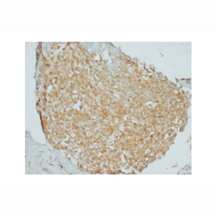Anti-SCYL1BP1/NTKLBP1: Rabbit SCYL1BP1/NTKLBP1 Antibody |
 |
BACKGROUND Two important cellular systems that regulate Golgi homeostasis are COPI-coated vesicles and the golgin family of molecules. The COPI vesicle system is an essential component for trafficking in the early secretory pathway, functioning within the Golgi stack and in a Golgi to endoplasmic reticulum (ER) retrograde pathway. COPI coats bud vesicles containing Golgi resident proteins, proteins that cycle between the ER and the Golgi, and ER resident proteins that have escaped from the ER. COPI trafficking is essential for cell growth and survival, as well as the maintenance of Golgi structure. Golgins are a class of Golgi-associated proteins that have been ascribed numerous functions in the cell including acting as tethers for incoming vesicles, laterally linking Golgi cisternae and regulating Golgi inheritance during mitosis. Golgins are peripheral membrane proteins containing extensive coiled-coil domains. They have a detergent resistant interaction with Golgi membranes and undergo exchange between their Golgi-associated and cytosolic pools. Golgins also interact with each other and with components of coated vesicle trafficking systems. In particular, golgins interact extensively with Rab GTPases, and through these interactions form a protein network that facilitates vesicle-docking events.1 Scy1-like 1 (Scyl1) is a member of the Scy1-like family of catalytically inactive protein kinases. SCYL1BP1, also known as NTKLBP1 or GORAB (Golgi-associated Rab-binding protein), was identified as a binding partner of SCYL1, also known as N-terminal kinase-like protein (NTKL). SCYL1BP1/ NTKLBP1 are highly expressed in skin and osteoblasts. The protein localizes to the Golgi apparatus and interacts with Rab6, identifying SCYL1BP1/ NTKLBP1 as a golgin. Gerodermia osteodysplastica is an autosomal recessive disorder characterized by wrinkly skin and osteoporosis. It was demonstrated that gerodermia osteodysplastica is caused by loss-of-function mutations in SCYL1BP1/ NTKLBP1, which led to abnormalities of the secretory pathway with age-related changes in connective tissues.2 In addition, SCYL1BP1/ NTKLBP1 was identified as an interacting partner of E3 ligase p53-induced RING H2 protein (Pirh2) and mouse MDM2 by yeast two-hybrid screening. Further investigation suggested there are two interactions involved in different mechanisms. SCYL1BP1/ NTKLBP1 can be ubiquitinated and degraded by Pirh2 but not by MDM2, which suggests that SCYL1BP1/ NTKLB1 can be regulated by Pirh2. On the other hand, while SCYL1BP1/NTKLBP1 binds to ubiquitin E3 ligase MDM2, it promotes MDM2 self-ubiquitination and results in a reduction of MDM2 protein level.3 Furthermore, it was shown that an increase in SCYL1BP1/NTKLBP1 protein levels caused a parallel change in the amount of p53 protein due to the inhibition by SCYL1BP1/NTKLBP1 of MDM2-mediated p53 ubiquitination. Thus, SCYL1BP1/NTKLBP1 is a novel regulator of the MDM2-p53 feedback loop and that it may be a potential tumor suppressor.4
REFERENCES
1. Ramirez, I. B-R. & Lowe, M.: Semin. Cell Dev. Biol. 20:770-9, 2009
2. Hennies,H.C. et al: Nature Genet. 40:1410-2, 2008
3. Yan, J. et al: FEBS lett. 584:3275-8, 2010
4. Yan, J. et al: FEBS lett. 584:4319-24, 2010
2. Hennies,H.C. et al: Nature Genet. 40:1410-2, 2008
3. Yan, J. et al: FEBS lett. 584:3275-8, 2010
4. Yan, J. et al: FEBS lett. 584:4319-24, 2010
Products are for research use only. They are not intended for human, animal, or diagnostic applications.
Параметры
Cat.No.: | CA1105 |
Antigen: | Short peptide from human SCYL1BP1/NTKLBP1 sequence. |
Isotype: | Rabbit IgG |
Species & predicted species cross- reactivity ( ): | Human, Mouse, Rat |
Applications & Suggested starting dilutions:* | WB 1:1000 IP n/d IHC 1:50 - 1:200 ICC n/d FACS n/d |
Predicted Molecular Weight of protein: | 30 kDa |
Specificity/Sensitivity: | Detects endogenous levels of SCYL1BP1/NTKLBP1 proteins without cross-reactivity with other related proteins. |
Storage: | Store at -20°C, 4°C for frequent use. Avoid repeated freeze-thaw cycles. |
*Optimal working dilutions must be determined by end user.
Документы
Информация представлена исключительно в ознакомительных целях и ни при каких условиях не является публичной офертой








